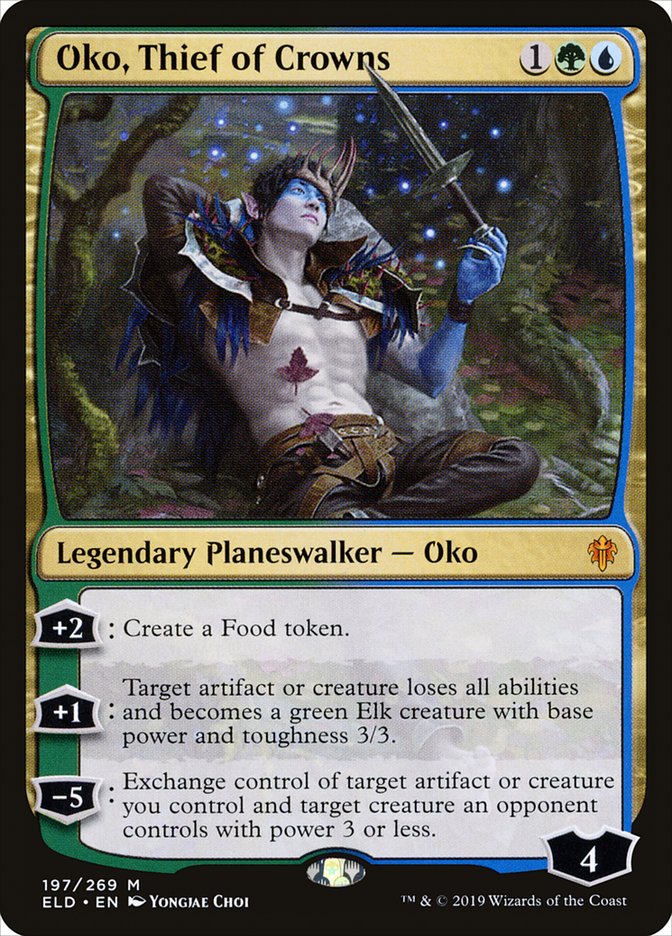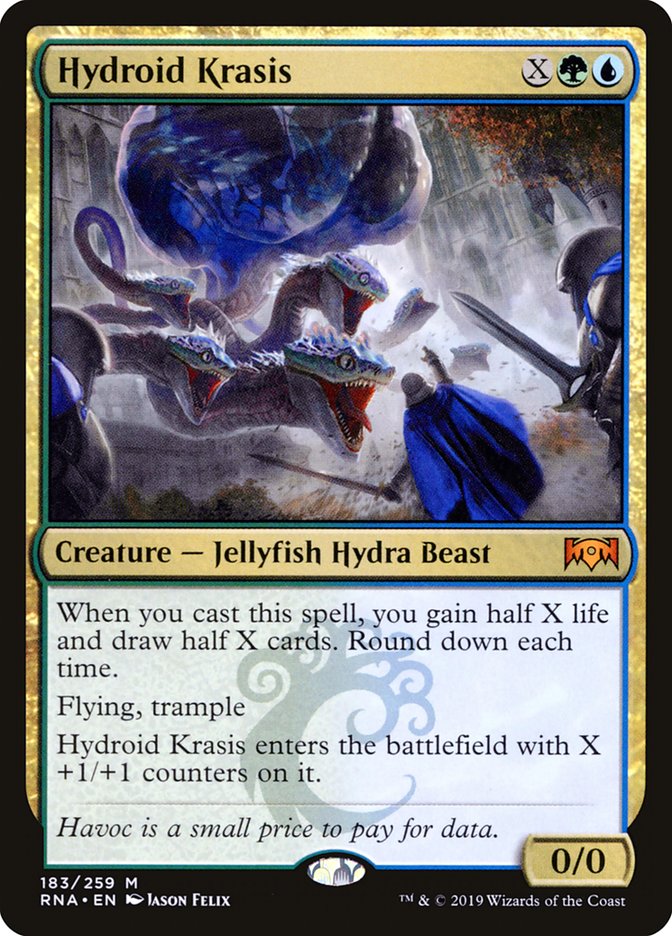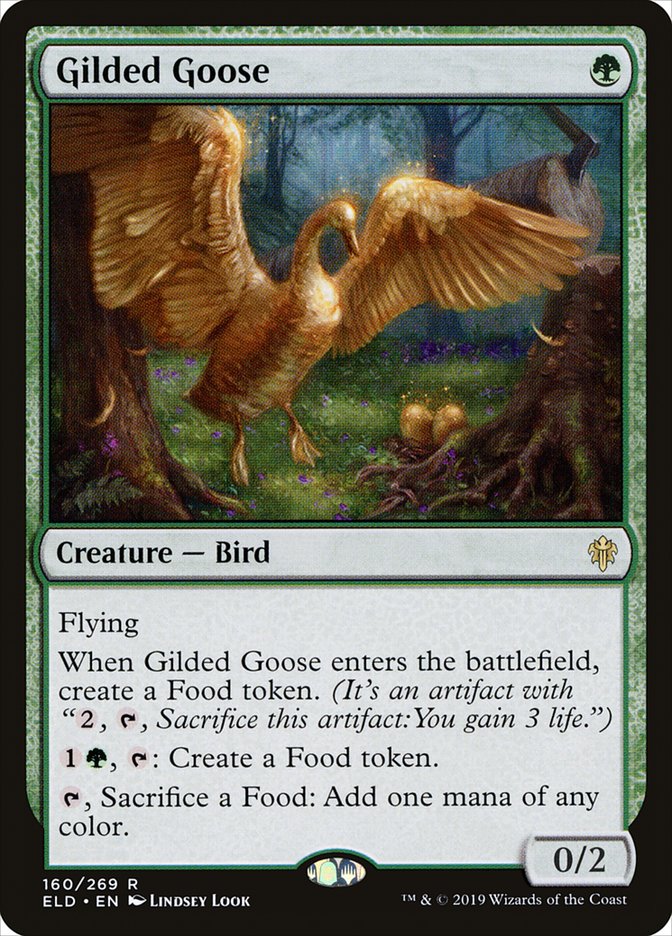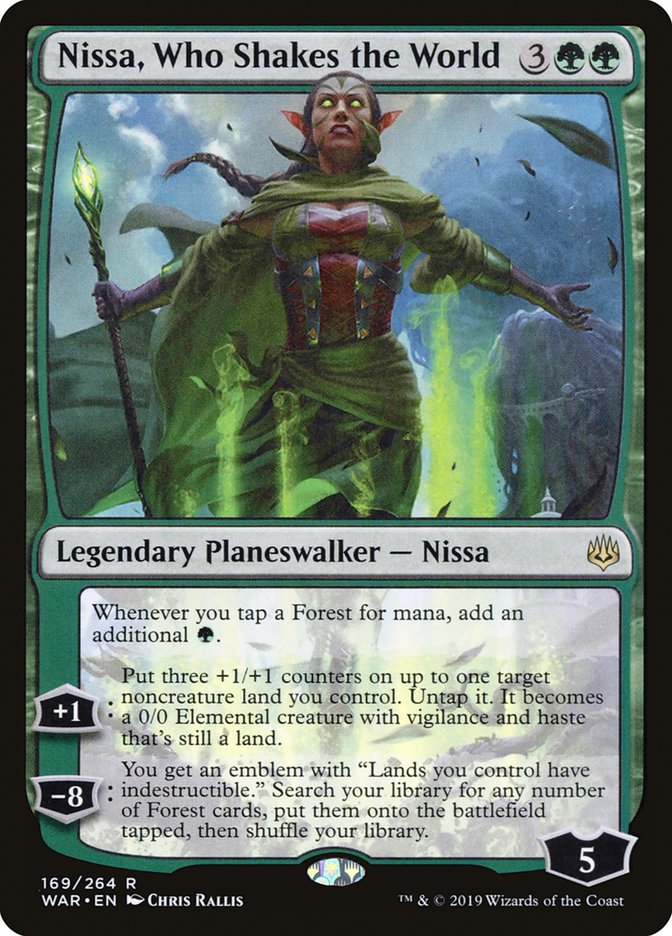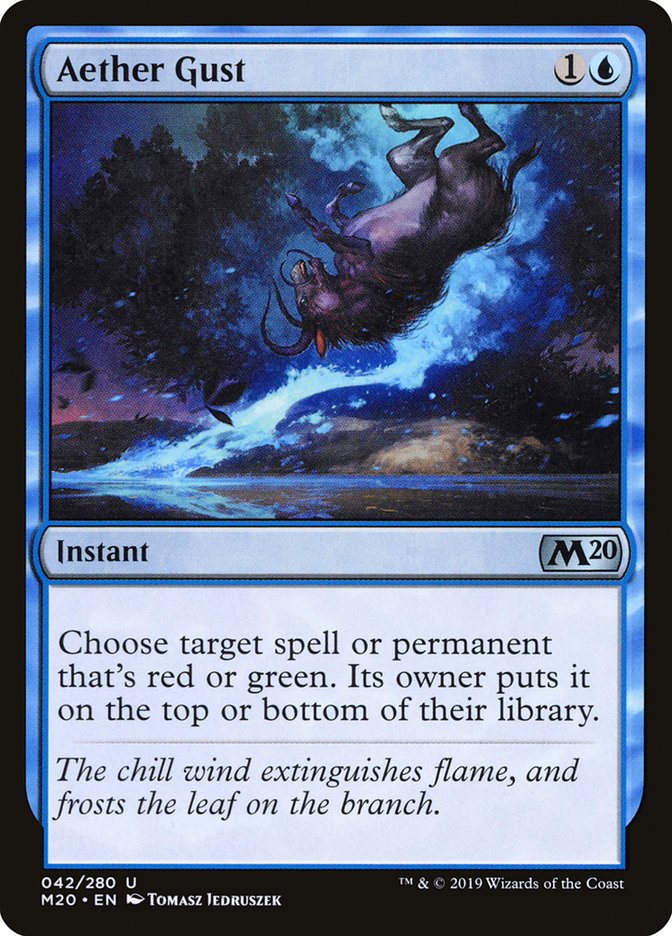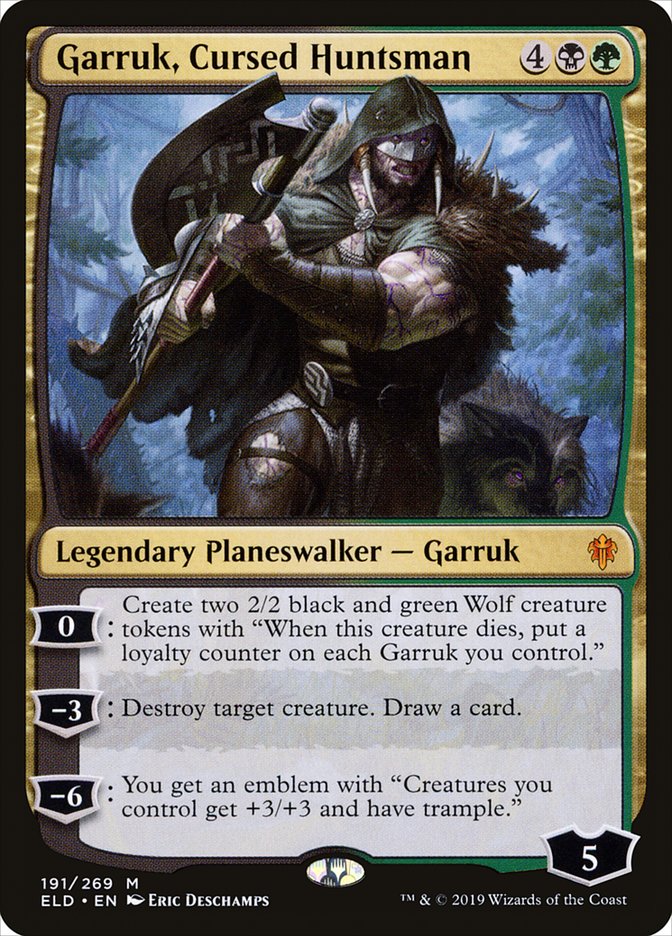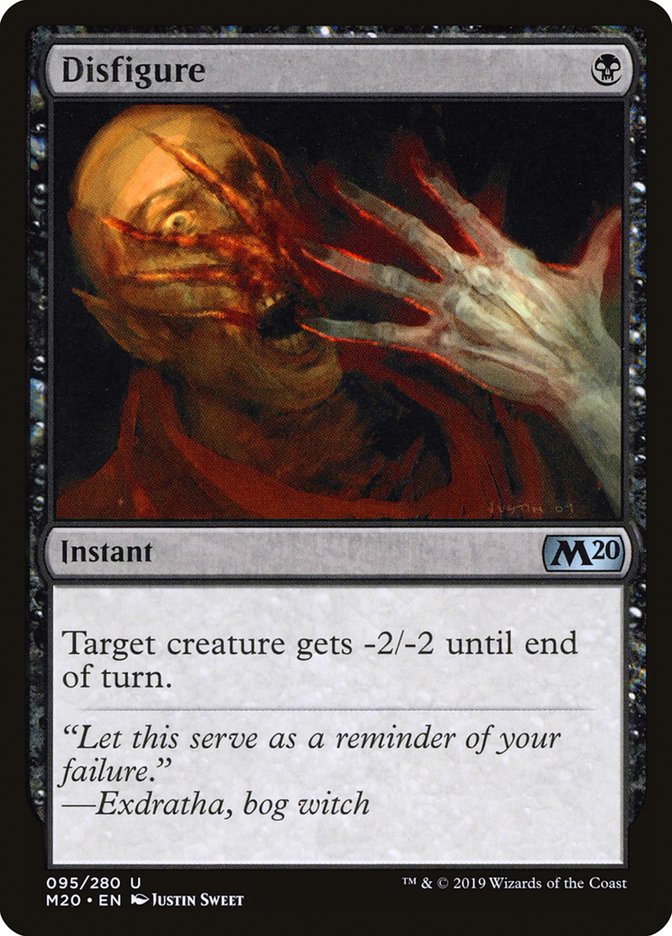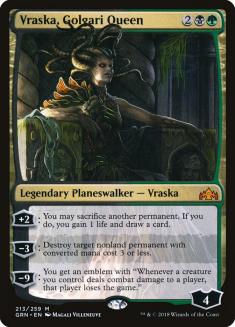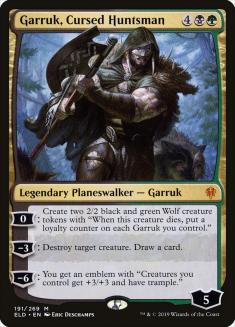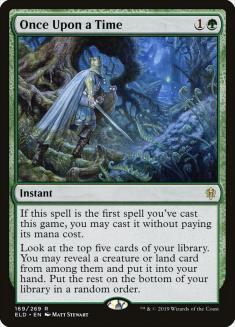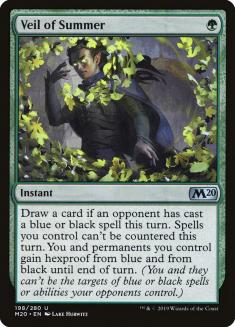Standard is a broken format. This is not news to literally anyone who has been paying attention. Wizards has printed a huge number of broken cards in Standard at the same time, in the same colors. As a result, we have the narrowest Standard metagame since the days of Caw-Blade. There is only one deck: Simic Food (sometimes with a splashed third color). There is only one matchup: the mirror. This article will arm you every scrap of knowledge I’ve gathered during the Mythic Championship preparation process. Let’s begin.
Fundamentals
Strategy in the mirror revolves around planeswalkers, protecting yours and attacking theirs. Planeswalkers generate cascading advantages, putting their controller further and further ahead each turn they’re on the battlefield. In this specific case, advantage typically takes the form of 3/3 bodies: Nissa, Who Shakes the World makes a 3/3 body every turn and Oko, Thief of Crowns makes one every other turn. This means that anything 4/4 or a larger is a brick wall in combat and anything smaller than that will have a lot of trouble attacking profitably.
Once one player has had a planeswalker active for a few turns, the other will be unable to deploy any ‘walker of their own, since it will be immediately lethally mobbed by 3/3s. In other words, being ahead on creatures matters, but only as a means to an end. If you need to choose between improving your battlefield of creatures and deploying a planeswalker, you should usually choose the latter. That is where the real battle is fought.
The lifegain from Food combined with the importance of planeswalkers means that you should almost never attack your opponent directly in the mirror. There are a few corner-case exceptions, but you should generally use your creatures to attack or defend planeswalkers and should almost never throw away resources to push through damage.
Paradise Druid often provides examples of this. You will typically be presented with opportunities to attack Paradise Druid into larger blockers in order to reduce your opponent’s life total. Do not take these lines. Even when mana is abundant, your Paradise Druid is capable of lethally attacking a planeswalker or saving yours with a chump block. Either of these is far more valuable than a few life points.
When deciding whether to attack their planeswalkers or stay home to protect yours, bear in mind that both Oko and Nissa are capable of generating three power of haste damage and that both Wicked Wolf and Noxious Grasp can remove a block. Thus, if you really need your planeswalker to survive, you should leave home at least one more blocker than they have attackers.
The latest R&D mistake is one of the trickiest cards to play in the mirror. The first thing you need to understand about this card is that it is beatable without a direct answer. Sometimes, it is correct to allow your opponent’s Oko to survive and to hold your Noxious Grasp for their Nissa. There are typically no sweepers in the mirror, so you don’t want to let them create an insurmountable battlefield advantage, but if you’re pressuring Oko with Wicked Wolf or similar, then waiting to Grasp it can be okay.
The second most important aspect of Oko is its ultimate. In general, you should not use this ability on Elk. Trading a 3/3 creature for a Food is not much better than just Elk’ing your own Food or making a Food. The ultimate costs loyalty and makes Oko vulnerable, while the other options increase his loyalty. That said, if you’re ever given the opportunity to trade a Food for a Wicked Wolf, you should do so. Wolf can profitably attack into swathes of 3/3s and feeding it usually isn’t particularly difficult. It is not as important as planeswalkers but still quite good.
You will only be able to make this exchange if your opponent doesn’t control a Food token, since activating Wolf in response to an exchange will fizzle the ability. Note that Elk lose their subtypes, and therefore cannot be sacrificed to Wicked Wolf even if they started as Food. The flip-side of this is that if your opponent controls an Oko on six or more loyalty, then you should not deploy an unprotected Wolf. Wait until you have a Food or have gotten in some beats.
There are two main creatures you’ll want to Elk on the opponent’s side of the board: Hydroid Krasis and Gilded Goose. Hydroid Krasis should be Elk’ed whenever you don’t have another answer to the card. Flying pressures planeswalkers far more effectively than a ground body ever could, regardless of size.
Elk’ing Gilded Goose is a far more complex play. The first thing to be aware of is that if you cast a Turn 2 Oko on the play, you should Elk their Goose more often than not. This play feels weird to make, since it puts your Oko under immediate pressure, but delaying their ‘walkers by a turn will often pay large dividends in terms of battlefield presence. I’ve found that whenever I have a Goose and they have a Turn 2 Oko, I’m praying that my opponent makes a Food. Later in the game, you should basically only Elk your opponent’s Goose if they have little or no Food on the battlefield and an Oko out. In that spot, turning their Goose into an Elk will substantially slow their Elk production in the long run.
The first and most important thing to understand about Nissa is that Nissa plus Hydroid Krasis is Splinter Twin — if either player ever assembles that combo, their opponent is almost certainly dead. As a result, if your opponent casts Nissa in a spot where they could plausibly have Krasis in hand, you should remove her at all costs. This is the time to throw away your smaller creatures, expose your planeswalkers, and get their Nissa dead however you have to. If your opponent topdecks Nissa, frequently you will be able to deduce that if they had Krasis, they would have already cast it. In these spots, you can be a little less desperate, although killing Nissa is still a huge priority.
The second important question with respect to Nissa is whether should you ultimate it on exactly eight loyalty. If you’ve reached that point without Nissa being answered, it’s pretty likely that your battlefield is large enough to defend it. But if for some reason it isn’t, then I would lean towards using the ultimate if you control at least one animated land. Even a single unkillable 3/3 buys a ton of time, and removing every Forest from your deck significantly improves your draws. Using the ultimate also locks in your ability to cast a big Krasis, which can be in doubt if Nissa is gradually worn down in combat or if they topdeck a Noxious Grasp.
When choosing which land to animate, the typical heuristic is that you should target whichever one is the least valuable, unless you need the mana from untapping a Forest this turn. Most of the time, you’ll be animating your non-Forest land to maximize your mana if they get traded off. Just be careful to avoid leaving yourself without blue or black mana.
The Decklist
Creatures (16)
Planeswalkers (10)
Lands (25)
Spells (9)
Sideboard

This decklist won not one but two PTQs last weekend. I won a local PTQ and Felix Sloo won a Magic Online PTQ. I know ultimately most of the cards are not innovative and most of this list is extremely stock, but let’s go over a few details.
I don’t really understand how the hivemind settled on exactly four of this effect. Noxious Grasp is one of the best ways to break serve and take games on the draw, and Aether Gust is situationally better, although worse overall. Putting their ‘walker back on top denies them an activation and will often put you far enough ahead to kill it immediately when they cast it. The fact that Gust actively good against Temur Reclamation is a nice bonus.
If you ask anyone why they’re playing Lilliana or Ugin over Garruk, Cursed Huntsman, they’ll tell you it’s because Garruk gets hit by cards like Noxious Grasp and Aether Gust. I don’t think this fact is important. Those cards are stretched incredibly thin in the mirror, and your opponents will not typically have the luxury of holding them for Garruk. Even if you happen to have a draw such that Garruk is your first threat, minus’ing Garruk will achieve a clean three-for-one into a potential Grasp. If Garruk sticks, he is completely dominant. His ultimate ends every game on the spot, and the threat of it generally means his Wolf tokens can’t be blocked or attacked into. That means that as long as Garruk is on the battlefield, you have free rein to attack opposing ‘walkers with hordes of Wolves.
I see a lot of people playing Legion’s End these days and I don’t really understand why. Disfigure is better against Edgewall Innkeeper, because instant speed means that even if they slow-roll it, they won’t be able to draw more than a single card. It also means you can answer it on Turn 1 on the draw. Against Mono-Red and Gruul, Disfigure hits all the same cards Legion’s End does for half the mana cost. All of that said, Innkeeper decks seem to be trending downward. This slot could be something else entirely.
Sideboarding
VS Sultai Food
Out (on the Play):
In (on the Draw):
In:
The true mirror is straightforward. Have as many planeswalker answers as you can and shave your most expensive card on the draw. I’ve toyed with sideboarding in Massacre Girl on the draw, but it’s awful when you’re ahead and bad at catching up.
VS Sultai Food with Casualties of War
Out:
In:
Against Casualties of War, you have to be prepared. But at the end of the day, your opponent’s deck likely has only six cards that are really vulnerable to Veil of Summer. As a result, I tend to bring in two, but not the full three. Negate can stop Nissa, so I think I would generally prefer to draw one of each, hence the two-two split.
VS Mass Manipulation Food
Out:
In:
Despite its performance in Lyon last weekend, I have not found Mass Manipulation to be very effective. It’s simply not that easy to arrange having at least one good target, a lot of mana, and an opponent who lacks a counterspell. Teferi, Time Raveler somewhat helps with the counterspell problem, but is easily answered by Noxious Grasp and Vraska. My suspicion is that the deck mainly performed well due to the ability of its pilots rather than because it was actually favored in the mirror. Because Aether Gust is not affected by Veil, I do not sideboard Veil in for this matchup.
It is extremely likely that I will be registering some version of Sultai Food at Mythic Championship Richmond. I cannot promise it will be this precise 75, but it won’t be far off. I expect Oko variants a whole to be well over half the field and that every major pro will be playing one. If you take nothing else away from this article, let it be this: register four copies of Oko, Thief of Crowns at your Standard tournament this weekend. You won’t regret it.


